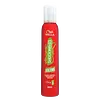What's inside
What's inside
 Key Ingredients
Key Ingredients

No key ingredients
 Benefits
Benefits

No benefits
 Concerns
Concerns

 Ingredients Side-by-side
Ingredients Side-by-side

Water
Skin ConditioningDimethyl Ether
SolventButane
Polyquaternium-16
Isobutane
Propane
Pvp
Emulsion StabilisingCocamidopropyl Pg-Dimonium Chloride Phosphate
Disodium EDTA
Cocamidopropyl Betaine
CleansingParfum
MaskingLaureth-12
EmulsifyingSodium Citrate
BufferingEthylhexylglycerin
Skin ConditioningCaffeine
Skin ConditioningTocopherol
AntioxidantPhenoxyethanol
PreservativeSodium Benzoate
MaskingButylphenyl Methylpropional
PerfumingLinalool
PerfumingWater, Dimethyl Ether, Butane, Polyquaternium-16, Isobutane, Propane, Pvp, Cocamidopropyl Pg-Dimonium Chloride Phosphate, Disodium EDTA, Cocamidopropyl Betaine, Parfum, Laureth-12, Sodium Citrate, Ethylhexylglycerin, Caffeine, Tocopherol, Phenoxyethanol, Sodium Benzoate, Butylphenyl Methylpropional, Linalool
Water
Skin ConditioningPropane
Pvp
Emulsion StabilisingButane
Vp/Va Copolymer
Isobutane
Chitosan
Phenoxyethanol
PreservativePolyquaternium-16
Formic Acid
PreservativeParfum
MaskingDisodium EDTA
Cetrimonium Chloride
AntimicrobialLaureth-4
EmulsifyingMethylparaben
PreservativeLinalool
PerfumingCitronellol
PerfumingLimonene
PerfumingHexyl Cinnamal
PerfumingCitric Acid
Buffering
 Reviews
Reviews

Ingredients Explained
These ingredients are found in both products.
Ingredients higher up in an ingredient list are typically present in a larger amount.
Butane is a gas derived from petroleum and natural gas. It is used as an aerosol propellant.
Disodium EDTA plays a role in making products more stable by aiding other preservatives.
It is a chelating agent, meaning it neutralizes metal ions that may be found in a product.
Disodium EDTA is a salt of edetic acid and is found to be safe in cosmetic ingredients.
Learn more about Disodium EDTAWe don't have a description for Isobutane yet.
Linalool is a fragrance and helps add scent to products. It's derived from common plants such as cinnamon, mint, citrus, and lavender.
Like Limonene, this ingredient oxidizes when exposed to air. Oxidized linalool can cause allergies and skin sensitivity.
This ingredient has a scent that is floral, spicy tropical, and citrus-like.
Learn more about LinaloolParfum is a catch-all term for an ingredient or more that is used to give a scent to products.
Also called "fragrance", this ingredient can be a blend of hundreds of chemicals or plant oils. This means every product with "fragrance" or "parfum" in the ingredients list is a different mixture.
For instance, Habanolide is a proprietary trade name for a specific aroma chemical. When used as a fragrance ingredient in cosmetics, most aroma chemicals fall under the broad labeling category of “FRAGRANCE” or “PARFUM” according to EU and US regulations.
The term 'parfum' or 'fragrance' is not regulated in many countries. In many cases, it is up to the brand to define this term.
For instance, many brands choose to label themselves as "fragrance-free" because they are not using synthetic fragrances. However, their products may still contain ingredients such as essential oils that are considered a fragrance by INCI standards.
One example is Calendula flower extract. Calendula is an essential oil that still imparts a scent or 'fragrance'.
Depending on the blend, the ingredients in the mixture can cause allergies and sensitivities on the skin. Some ingredients that are known EU allergens include linalool and citronellol.
Parfum can also be used to mask or cover an unpleasant scent.
The bottom line is: not all fragrances/parfum/ingredients are created equally. If you are worried about fragrances, we recommend taking a closer look at an ingredient. And of course, we always recommend speaking with a professional.
Learn more about ParfumPhenoxyethanol is a preservative that has germicide, antimicrobial, and aromatic properties. Studies show that phenoxyethanol can prevent microbial growth. By itself, it has a scent that is similar to that of a rose.
It's often used in formulations along with Caprylyl Glycol to preserve the shelf life of products.
We don't have a description for Polyquaternium-16 yet.
Propane is a gas derived from petroleum and natural gas. It is used as a propellant.
This ingredient is most commonly used in shaving cream, hair products, and makeup.
Pvp is a water-soluble synthetic polymer and common hairstyling ingredient. It is a film-forming ingredient and used to "hold" specific shapes of hair.
Pvp is less effective in high-humidity. It tends to draw moisture, but this moisture dismantles the structure and "hold".
Water. It's the most common cosmetic ingredient of all. You'll usually see it at the top of ingredient lists, meaning that it makes up the largest part of the product.
So why is it so popular? Water most often acts as a solvent - this means that it helps dissolve other ingredients into the formulation.
You'll also recognize water as that liquid we all need to stay alive. If you see this, drink a glass of water. Stay hydrated!
Learn more about Water